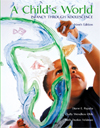Diane E. Papalia,
University of Wisconsin-Madison
Sally Wendkos Olds
Ruth Duskin Feldman
| child development | scientific study of processes of change and stability from conception through adolescence
|
 |
 |
 |
| cohort | group of people who share a similar experience, such as growing up at the same time and in the same place.
|
 |
 |
 |
| critical period | specific time when a given event, or its absence, has the greatest impact on development
|
 |
 |
 |
| culture | a society's or group's total way of life, including customs, traditions, beliefs, values, language, and physical products-all learned behavior passed on from parents to children.
|
 |
 |
 |
| environment | totality of nonhereditary, or experiential, influences on development
|
 |
 |
 |
| ethnic group | group united by ancestry, race, religion, language, and/or national origins, which contribute to a sense of shared identity.
|
 |
 |
 |
| extended family | kinship network of parents, children, and other relatives, sometimes living together in an extended-family household.
|
 |
 |
 |
| heredity | inborn influences or traits inherited from biological parents.
|
 |
 |
 |
| individual differences | differences among children in characteristics, influences, or developmental outcomes
|
 |
 |
 |
| maturation | unfolding of a natural sequence of physical and behavioral changes, including readiness to master new abilities.
|
 |
 |
 |
| nonnormative | characteristic of an unusual event that happens to a particular person, or a typical event that happens at an unusual time of life.
|
 |
 |
 |
| nuclear family | kinship and household unit made up of parents and their natural or adopted children.
|
 |
 |
 |
| plasticity | modifiability of performance
|
 |
 |
 |
| qualitative change | change in kind, structure, or organization, such as the change from nonverbal to verbal communication
|
 |
 |
 |
| quantitative change | change in number or amount, such as in height, weight or size of vocabulary.
|
 |
 |
 |
| risk factors | conditions that increase the likelihood of a negative developmental outcome.
|
 |
 |
 |
| social construction | concept about the nature of reality, based on societally shared perceptions or assumptions
|
 |
 |
 |
| socioeconomic status (SES) | conditions that increase the likelihood of a negative developmental outcome.
|



 2002 McGraw-Hill Higher Education
2002 McGraw-Hill Higher Education